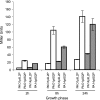The Pseudomonas aeruginosa pathogenicity island PAPI-1 is transferred via a novel type IV pilus
- PMID: 20363934
- PMCID: PMC2897670
- DOI: 10.1128/JB.00041-10
The Pseudomonas aeruginosa pathogenicity island PAPI-1 is transferred via a novel type IV pilus
Abstract
Pseudomonas aeruginosa is a major cause of nosocomial infections, particularly in immunocompromised patients or in individuals with cystic fibrosis. The notable ability of P. aeruginosa to inhabit a broad range of environments, including humans, is in part due to its large and diverse genomic repertoire. The genomes of most strains contain a significant number of large and small genomic islands, including those carrying virulence determinants (pathogenicity islands). The pathogenicity island PAPI-1 of strain PA14 is a cluster of 115 genes, and some have been shown to be responsible for virulence phenotypes in a number of infection models. We have previously demonstrated that PAPI-1 can be transferred to other P. aeruginosa strains following excision from the chromosome of the donor. Here we show that PAPI-1 is transferred into recipient P. aeruginosa by a conjugative mechanism, via a type IV pilus, encoded in PAPI-1 by a 10-gene cluster which is closely related to the genes in the enterobacterial plasmid R64. We also demonstrate that the precursor of the major pilus subunit, PilS2, is processed by the chromosomally encoded prepillin peptidase PilD but not its paralog FppA. Our results suggest that the pathogenicity island PAPI-1 may have evolved by acquisition of a conjugation system but that because of its dependence on an essential chromosomal determinant, its transfer is restricted to P. aeruginosa or other species capable of providing a functional prepilin peptidase.
Figures





References
-
- Akahane, K., D. Sakai, N. Furuya, and T. Komano. 2005. Analysis of the pilU gene for the prepilin peptidase involved in the biogenesis of type IV pili encoded by plasmid R64. Mol. Genet. Genomics 273:350-359. - PubMed
-
- Bougdour, A., C. Lelong, and J. Geiselmann. 2004. Crl, a low temperature-induced protein in Escherichia coli that binds directly to the stationary phase sigma subunit of RNA polymerase. J. Biol. Chem. 279:19540-19550. - PubMed
Publication types
MeSH terms
Substances
Grants and funding
LinkOut - more resources
Full Text Sources

